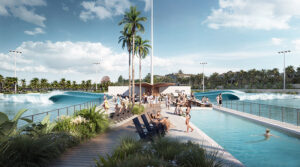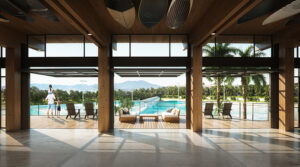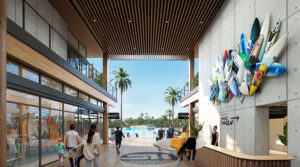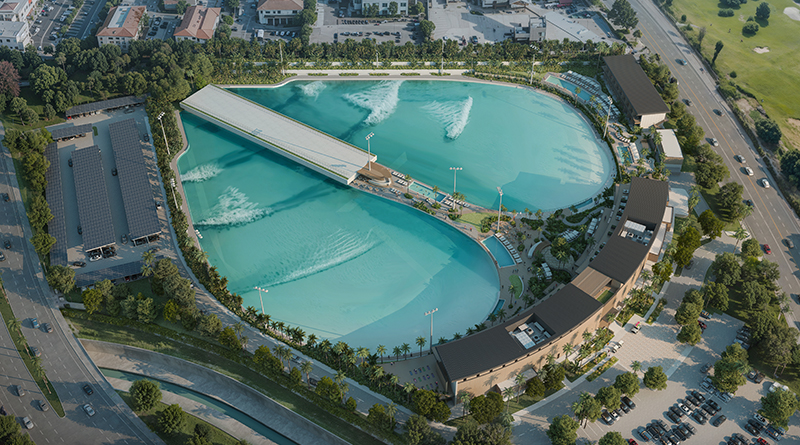The Newport Beach City Council voted to approve the controversial Snug Harbor Surf Park following more than two hours of public comment and months of debate over whether an artificial wave pool belongs in a coastal community already surrounded by surf breaks. The project, proposed for the Newport Beach Golf Course at 3100 Irvine Avenue, will replace the driving range, putting green, restaurant, and three of the course’s holes with a state-of-the-art wave facility. The remaining fifteen holes will remain in operation, according to city plans.

The approval came after a lengthy review process that included circulation of a draft Environmental Impact Report under the California Environmental Quality Act and multiple public hearings before the Planning Commission and the City Council. The final vote was 6-0, with one councilmember abstaining due to a potential conflict of interest. The land is privately owned, but the decision has ignited passionate reactions throughout the community.
According to city documents, the Snug Harbor project covers about fifteen acres and will feature approximately five acres of surf lagoons surrounded by viewing platforms, seating areas, three warming pools, and a spa. A three-story clubhouse will include a reception area, surf academy, fitness and yoga studios, administration offices, retail, a restaurant, and a coffee bar. A second building will provide accommodations for athletes, with twenty units that include beds, bathrooms, closets, and patios overlooking the lagoon. Basements will house surfboard and golf cart storage as well as maintenance and mechanical areas. Two parking lots will provide nearly four hundred total spaces, and the design incorporates solar canopies above parking areas and rooftops to power the wave-making machinery and heat the pools during daylight hours.

Supporters of the project, including several city officials, described the future wave park as a world-class amenity that could make Newport Beach a training hub for surfers and water athletes. Some have argued that the project will benefit local youth programs by offering a reliable training environment unaffected by the unpredictable ocean conditions that can limit practice sessions. Coaches and recreation advocates have noted that many mornings on the coast are marked by wind, chop, or flat seas that prevent effective surf training. A controlled wave pool, they said, will allow surfers, swimmers, and lifeguards to develop their skills in a safe and consistent setting.
Public Information Manager for the City, John Pope explained that supporters of the project largely view it as a forward-thinking addition to the city’s recreational offerings. “Generally, the proponents were in favor of the project as a way to learn and practice surfing in a controlled environment with predictable waves, as well as for hosting surf competitions,” Pope said, referencing the October 28 City Council meeting, which included two hours of testimony from both sides. “The opponents were speaking against the loss of part of the golf course, though part of the course is owned by the County and will remain.”

Proponents also believe the project will enhance tourism and economic activity, drawing both visitors and locals to a new kind of recreational destination that includes dining, fitness, and lodging components. City staff have maintained that the site’s proximity to John Wayne Airport, which subjects the area to significant aircraft noise, reduces the likelihood that wave machine operations will disturb nearby neighborhoods. The inclusion of solar energy infrastructure has been promoted as a sustainable feature that could offset the power requirements of the wave system and pool heating equipment. Those in favor see the development as a forward-thinking investment that aligns with Newport Beach’s image as an upscale yet active coastal community.
Opposition to the Snug Harbor project has been equally strong. Many residents view the Newport Beach Golf Course as one of the last affordable places in the city to play and practice golf. The course offers rounds at about forty dollars, far below the rates at nearby luxury courses, which can cost several hundred dollars or require costly memberships. For decades, locals have used the course for recreation, family outings, and school sports programs, and some feel the loss of any part of that space represents the erosion of a long-standing community amenity.

A group called Save the Newport Beach Golf Course organized outside City Hall before the meeting, arguing that the course is a vital part of the neighborhood’s character and that it provides physical and social benefits for veterans, seniors, families, and students. They have called the golf course a community treasure and expressed concern that its partial replacement will leave few options for casual golfers in the area. While the land is privately owned, opponents note that it’s open, green character has long given residents the feeling of shared public space.
Environmental concerns have also fueled opposition. Conservation advocates argue that converting grassland and open space into artificial lagoons will harm local wildlife and reduce available habitat. Representatives from the Newport Bay Conservancy and other organizations have expressed disappointment that a property zoned for parks and recreation would be used for what they describe as a more intensive commercial use. They have questioned the project’s water demand, particularly given California’s recurring droughts, and raised alarms about potential noise pollution and light impacts from nighttime operation or large-scale events.

Pope acknowledged that these concerns were part of the City Council’s discussion but clarified the city’s role in the process. “It is important to keep in mind that this is a private development on privately owned land, as opposed to something like a city-owned park or recreation facility,” Pope said. “Therefore, the city’s role is limited to determining whether the development application fits the zoning requirements and does not present unmitigated environmental impacts.”
He added that the Environmental Impact Report addressed those concerns in detail and that the council had to balance resident sentiment with the developer’s rights. “As several of our council members noted in their approval of the project, they understood the affection that some residents have for the existing golf course but also respected the rights of the landowner to develop the property with a new vision,” Pope said.
City officials have emphasized that the project meets the city’s general plan and zoning requirements once amended, and that the owner has the right to lease the property for uses consistent with its commercial recreation designation. Several council members acknowledged the emotional divide among residents but concluded that the city’s obligation was to ensure that any development met all regulatory and environmental standards. They described the project as a creative solution that allows both golf and surfing to coexist on the site.
 The Snug Harbor project’s approval marked the end of a long review process that began with an application in April 2024 and included multiple hearings before the Planning Commission, an environmental scoping meeting, and public circulation of the draft EIR from May to July 2025. The Orange County Airport Land Use Commission had initially raised concerns due to the site’s location near flight paths, but the City Council voted to overrule the commission’s findings, noting that the proposed use was compatible with existing conditions.
The Snug Harbor project’s approval marked the end of a long review process that began with an application in April 2024 and included multiple hearings before the Planning Commission, an environmental scoping meeting, and public circulation of the draft EIR from May to July 2025. The Orange County Airport Land Use Commission had initially raised concerns due to the site’s location near flight paths, but the City Council voted to overrule the commission’s findings, noting that the proposed use was compatible with existing conditions.
Going forward, the project will require final certification of its Environmental Impact Report and the issuance of building permits. Construction is expected to begin following the completion of these steps, with an anticipated opening date projected for 2028.
The development’s approval reflects the City Council’s intent to balance modernization with tradition, but it also highlights the broader challenge coastal cities face when weighing economic growth against the preservation of open space. As Pope noted, the city’s review process focused on ensuring the proposal met environmental and zoning criteria, while the larger community discussion reflected Newport Beach’s deep attachment to its remaining green spaces.
The wave park’s supporters celebrated the decision as a step toward innovation in recreation, while opponents continued to express disappointment over the loss of familiar landscapes and affordable activities. As Newport Beach continues to evolve, the Snug Harbor Surf Park stands as a symbol of that transformation — an emblem of progress for some and a cautionary tale for others. Its future as either a beloved new landmark or a controversial reminder of changing priorities will depend on how well the project integrates with the community in the years ahead.
For more information, please visit https://www.newportbeachca.gov/government/departments/community-development/planning-division/current-projects-and-cases/snug-harbor-surf-park-project.





